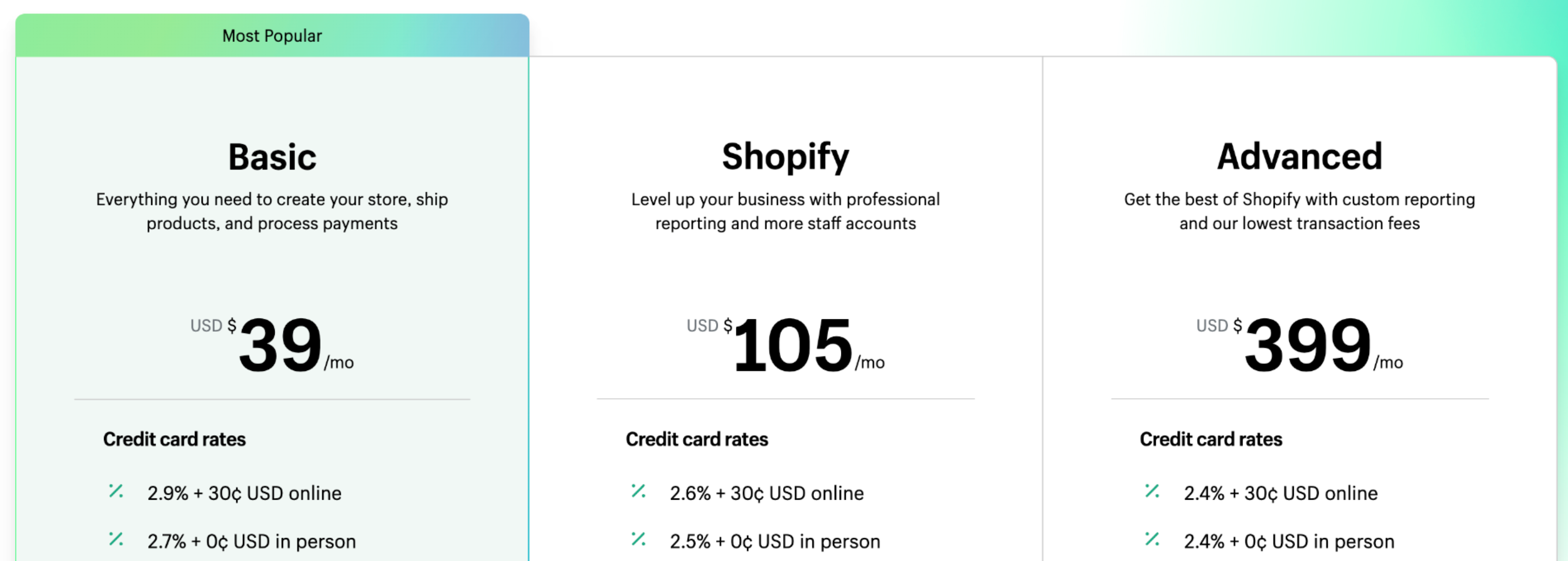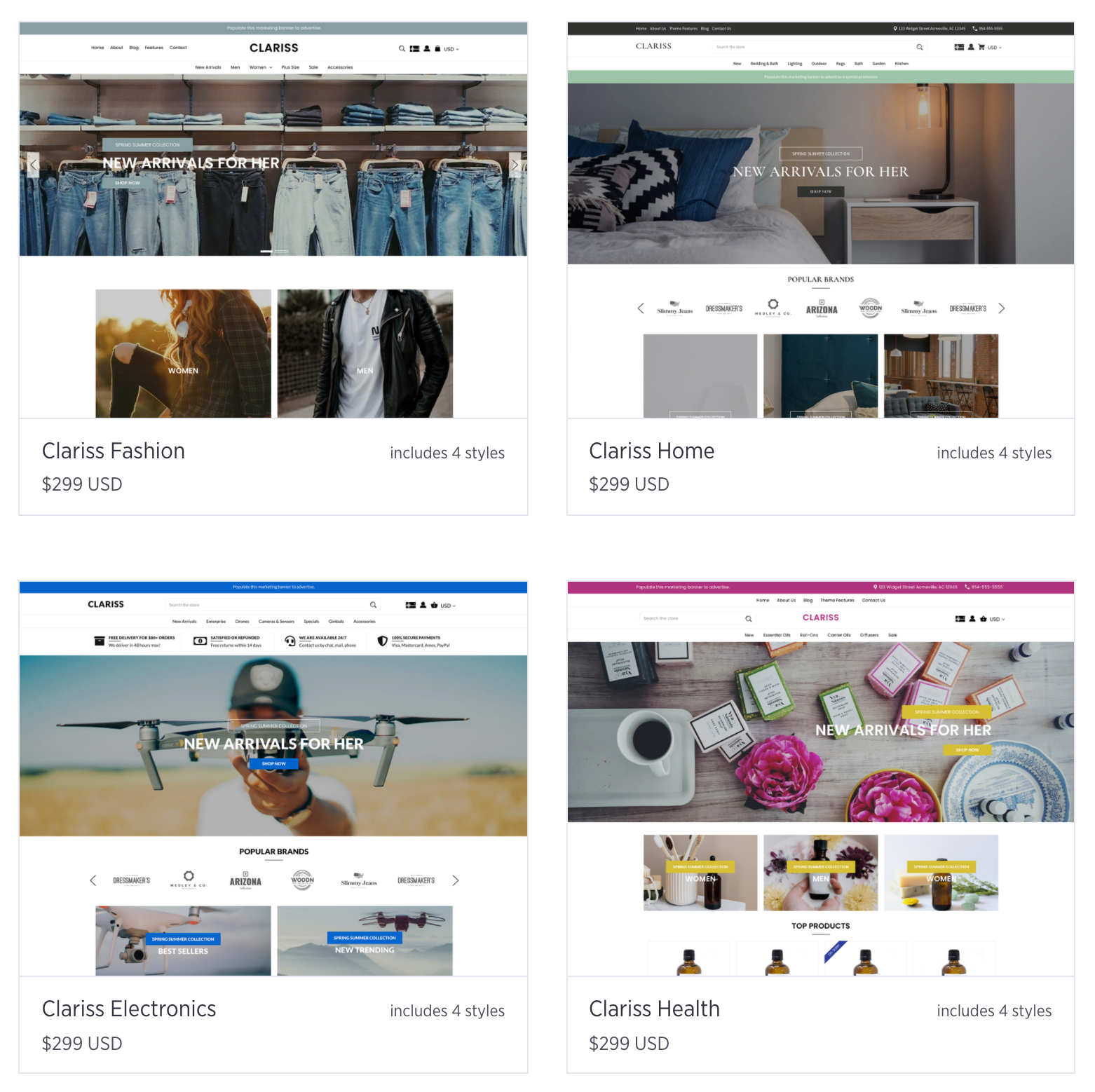BigCommerce vs. Shopify: Which is better?
Choosing between these two ecommerce platforms isn’t easy. Undoubtedly, they’re two of the best platforms out there and they have much in common. However, there are plenty of differences between BigCommerce and Shopify that are worth evaluating before you make a decision.
And it’s best to choose carefully.
Committing to an ecommerce platform is a huge decision. Whichever one you pick will become your business’s mission control — virtually every aspect of your business will need to be managed from the platform.
So, what do you need to know to make an informed choice?
In this article, you’ll get a blow-by-blow comparison of BigCommerce and Shopify. By the end of this article, you should be ready to sign up for your chosen platform and start building your business with confidence.
Disclosure: This website is a part of Shopify inc. media properties. Although we strive to publish objective, accurate, and factual content, this article may contain biased opinions.
BigCommerce vs. Shopify: The Basics
BigCommerce was founded in 2009 and today it supports more than 60,000 stores, 2,000+ mid-market businesses, and 30 Fortune 1000 companies. The company has more than 800 employees working to provide a brilliant ecommerce platform.

Shopify was founded way back in 2006 and powers more than 1 million merchants around the world. The company also has a whopping 7,000 employees working to develop a complete ecommerce and retail technology business solution.

Both BigCommerce and Shopify allow merchants to build ecommerce websites, process payments, sell products via multiple online sales channels, manage inventory, and more.
But right off the bat, it’s clear that Shopify is the larger company, by far. This size allows it to build and manage more tools and features. This is a theme you’ll see play out throughout the rest of this article.
Still, bigger isn’t always better, so let’s take a closer look!
Shopify vs. BigCommerce: Which One is Best for Your Business?
We’re going to compare Shopify and BigCommerce in 9 key areas:
- Pricing plans
- Payment gateways
- Sales limits
- Themes and templates
- App stores
- Reporting and analytics
- Mobile apps
- Point of sale (POS)
- Dropshipping
First up?
1. BigCommerce vs. Shopify Pricing
Costs are often one of the most important considerations for new businesses. So, how much do these platforms charge? Here's a quick rundown of BigCommerce versus Shopify pricing.
BigCommerce has four pricing plans:
- Bigcommerce Standard: $29.95 per month
- Bigcommerce Plus: $79.95 per month
- Bigcommerce Pro: $299.95 per month
- Bigcommerce Enterprise: Custom plans for large businesses.
You can save 10% on the Plus and Pro plans by purchasing a one-year subscription upfront.

Shopify has 4 equivalent pricing plans:
- Basic Shopify Plan: $39 per month
- Shopify: $105 per month
- Advanced Shopify: $399 per month
- Shopify Plus: Custom plans for enterprises.
Shopify also offers an additional plan called ‘Shopify Starter’ for just $5 per month. This plan gives merchants access to all of Shopify’s sales channels, enabling you to sell online via messaging and social apps. You can also create a basic storefront to kickstart your ecommerce journey.
Like BigCommerce, Shopify provides a 10% discount on annual plans and a 20% discount when purchasing a two-year subscription upfront.

Both BigCommerce and Shopify offer a free trial.
All in all, BigCommerce and Shopify have very similar pricing.
2. BigCommerce vs. Shopify Payment Gateways
To sell online, you need a gateway to process payments, such as Stripe or PayPal.
BigCommerce integrates with 65 popular payment gateways, whereas Shopify integrates with more than 100 payment gateways — including its own, which is called Shopify Payments.
However, Shopify charges transaction fees if you don’t use Shopify Payments and opt to use a third-party payment gateway. These fees depend on your plan:
- Basic Shopify – 2%
- Shopify (regular) – 1%
- Shopify Advanced – 0.5%
On the other hand, BigCommerce doesn’t charge any transaction fees regardless of which gateway you use.

This is a clear win for BigCommerce. However, it’s worth noting that it can be challenging to integrate and manage third-party gateways — especially if you’re not super tech-savvy. Shopify Payments was designed to make this process easier for merchants and involves far less setup.
BigCommerce does provide a streamlined, recommended gateway: PayPal powered by BrainTree. But it’s still an integration, which makes it arguably less streamlined than Shopify’s proprietary offering.
Shopify Payments allows your customers to pay you via all the major methods, too. So unless you have a strong preference for another payment gateway, there’s really no reason not to use the service.

Ultimately, this comes down to preference.
If you want to use a particular third-party payment gateway, BigCommerce allows you to avoid additional fees. However, if you want to keep things as simple as possible, Shopify Payments is the way to go.
3. BigCommerce vs. Shopify Sales Limits
Let’s cut to the chase: BigCommerce has annual sales limits for each of its plans:
- Bigcommerce Standard: $50,000
- Bigcommerce Plus: $180,000
- Bigcommerce Pro: $400,000
- Bigcommerce Enterprise: Negotiable
In short, if you hit these limits, you’ll be forced to upgrade to the next plan.

Shopify has no sales limits on any of its plans — which means you can stick to your preferred plan forever or upgrade when it suits you.
4. BigCommerce vs. Shopify Themes
Both BigCommerce and Shopify provide free and paid website themes that you can customize to get your store looking the way you want. Here’s how the platforms compare:
- BigCommerce: 12 free themes and 130 premium themes (that cost between $165 and $250).
- Shopify: 8 free themes and 64 paid themes (that cost between $120 and $180).
BigCommerce wins in terms of volume here, however many of the themes are simply variations and not standalone themes. For example, in the image below you can see different versions of the Clariss theme that are very similar.

Although Shopify has fewer themes available, they’re more varied.

Overall, both platforms provide a range of professional themes, but Shopify seems to offer more variety in terms of layouts.
5. BigCommerce vs. Shopify Apps
Shopify and BigCommerce have their own app stores. These app stores play host to a range of proprietary and third-party applications that allow you to extend the functionality of your site.
For example, you can use apps to add popups, live chat, bundled products, or social media feeds to your site.
The Shopify app store contains more than 6,000 Shopify apps and integrations, whereas BigCommerce’s app store has around 850.
Shopify’s size makes it the clear winner here. The platform has a much larger user base and so third-party developers are more likely to create tools for the platform.
In fact, Shopify’s app store is so large, there’s an app for virtually everything and anything you can think of.

6. BigCommerce vs. Shopify Reporting and Analytics
In an ultra-competitive environment like ecommerce, data is more important than ever — after all, knowledge is power.
For example, you may want to track your customer retention rate and average order value. And as your business grows, you’ll likely want to produce financial reports to track things like revenue, profit, and taxes.
So, let’s compare Shopify and BigCommerce reporting and analytics tools.

Both platforms provide a robust set of tools that allow in-depth analysis.
However, BigCommerce’s professional reporting tools are available on all plans. On the other hand, Shopify staggers its reporting tools to encourage you to upgrade as you grow. As a result, the Basic Shopify plan has simple to follow, but fairly basic analytics capabilities.

That said, both platforms come with Google Analytics integrations to create custom reports and track key performance indicators (KPIs).
7. BigCommerce vs. Shopify Point of Sale (POS)
Point of sale (POS) solutions allow you to process payments and manage your business when selling in-person. Plus, integrating your ecommerce store with a POS solution is the best way to maintain accurate and up-to-date inventory, sales, and customer data records.
Shopify has an out-of-the-box solution aptly named “Shopify POS” that comes with every Shopify plan — including the Lite plan, for just $9 per month. Shopify also provides a range of POS hardware.

The Lite Plan offers a great way to get started with POS, but if you’d like to access Shopify POS’s full range of features, you’ll need to upgrade to Shopify POS Pro for $89 per month.
If you want to sell in-person with BigCommerce, you’ll need to integrate a third-party POS service, such as Vend, Square, or Clover. Each of these services comes with its own strengths, weaknesses, and pricing.
Simply put, BigCommerce offers flexibility without additional fees, but Shopify provides a more streamlined approach that means merchants don’t have to worry about integrating two different systems.
8. BigCommerce vs. Shopify Mobile Apps
Shopify and BigCommerce provide apps to help you manage your business on the go. Let’s take a closer look.
BigCommerce provides a mobile app that allows you to do things like get push notifications for new orders, manage orders, view basic analytics, and contact customers.

Shopify offers three apps to manage your business: Shopify, Shopify POS, and Ping.
Shopify’s main app allows you to do much more than BigCommerce’s app. Here are some of the features:
- Manage orders
- Manage products and collections
- Run marketing campaigns
- Follow up with customers
- Create discounts
- Review store performance
- Customize your store’s theme
- Extend your store’s features with apps
The Shopify POS app allows you to take and manage in-store sales, refunds, and exchanges. You can also add apps to help grow your business, such as customer loyalty apps.
Of course, if you opt to use BigCommerce, most leading third-party POS solutions will provide a mobile app.
Finally, Shopify also offers Ping. This messaging app allows you to connect with customers via Shopify Chat, Apple Business Chat, and Messenger, all in one place — this is a game changer when it comes to improving customer satisfaction.

To summarize, it’s fair to say that Shopify makes it far easier to manage your business from your smartphone.
9. BigCommerce vs. Shopify Dropshipping
Dropshipping is a product sourcing and fulfillment method that allows virtually anyone to start selling online in minutes.
Instead of purchasing products upfront to sell, you can partner with a dropshipping supplier who will store, manage, and ship products to customers on your behalf.

You can also dropship print-on-demand products — these are generic products featuring your original designs and branding, such as clothing, accessories, or homeware.
Dropshipping is a fantastic way to start an online business as you don’t need to invest money in inventory. It’s also a great way to extend existing product lines quickly and easily.
So, which is better for dropshipping: Shopify or BigCommerce?
Both platforms offer a range of dropshipping apps, including popular services like AliExpress Dropshipping and print-on-demand apps like Printful and Spocket.
However, as mentioned above, Shopify’s app store is significantly larger than BigCommerce’s app store. Consequently, it also has many more dropshipping apps available, making it easy to start an ecommerce business.
Executive Summary: Shopify or BigCommerce?
Undoubtedly, Shopify and BigCommerce are both incredible commerce platforms, offering a vast range of features to help you manage and grow your business.
If you’re looking for advanced reporting and analytics straight out the gate, then BigCommerce may be for you.
However, Shopify is arguably the better solution thanks to its lack of sales limits, varied themes, mobile apps, out-of-the-box POS system, and the massive amount of apps available. Check it out for yourself by signing up for Shopify’s free trial.
